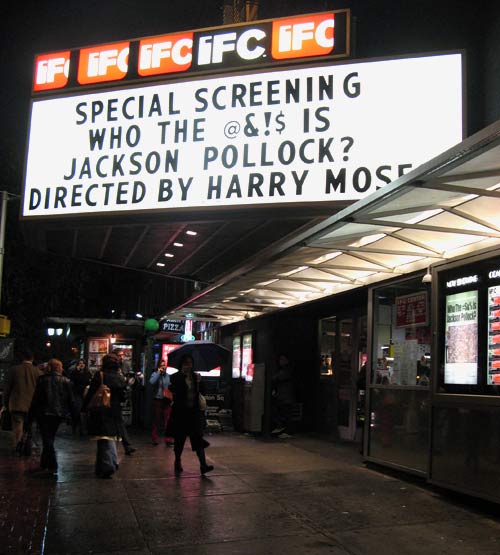Day: November 8th, 2006
Horton sees a Pollock
I attended the New York premiere for Harry Moses’ new documentary, “Who the #$&% is Jackson Pollock?” at the IFC Center.

It tells the fascinating, often hilarious, story of retired long-haul truck driver Teri Horton, who has in her possession a 66″ x 48″ paint-splattered canvas which she bought as a gag for a friend, that may be an original Jackson Pollock painting worth tens of millions of dollars. That is, if it can be certified as a genuine Pollock, which it currently cannot.
In 1992, Horton picked up the painting in question at a San Bernadino thrift shop for $5 — she refused to pay $8 — and then lugged it to her friend’s mobile home in the flatbed of her truck. The friend got a big laugh out of the hideous present, but turned it down because it barely fit through her trailer door. The painting went into storage, and was later hauled out for a yard sale where it was spied by a local art teacher, who advised Horton that the painting bore a remarkable resemblance to work by the leading 20th Century American artist, Jackson Pollock. Horton’s response (in its uncensored form) gives the film its title.
What followed was an arduous quest to authenticate the unsigned, provenance-less painting, fleshed out by a colorful cast of mostly condescending and dismissive art world establishment players (former Metropolitan Museum of Art director Thomas P.F. Hoving comes off particularly insufferable, snooting remarks like “She knows nothing. I am an expert.”), wealthy dealers and businessmen, a master art forger, a slick-talking convicted felon, a Quebecois forensic investigator, guitar-strumming, cowboy-hatted friends and relatives and at the center of it all: a fiesty mid-septuagenarian with a whisky and cigarettes voice and a mouth like a sailor. New York Times writer Randy Kennedy explores the long, strange trip of Horton and her painting in a story that appeared on the front page of the Arts section the next day.
Director Moses and father and son producers Don and Steven Hewitt were also in attendance at the premiere, as were many of they key figures of the film. Horton included — along with her four grown children who, we were told that night, all met for the first time over the previous weekend. (One senses, and the film alludes to it briefly, that Horton has had a long and troubled life.) Hoving declined the invitation.
Don Hewitt, best known as creator and longtime executive producer of 60 Minutes, with Horton:

What struck me about the film, beside the fantastically improbable story, was how Horton has adopted the painting as her raison d’être. Early into the process, Horton turned down $2 million for the unauthenticated painting, much to the dismay of her family. She continued to doggedly pursue the matter, but despite additional evidence (including the discovery by forensic art expert Peter Paul Biro of a fingerprint in paint on the back of her canvas, matching one found in Pollock’s East Hampton studio), the established art world still refused to validate her Pollock… and perhaps by extension, outsider Horton.
The film’s closing credits reveal that Horton was offered $9 million for her painting by a Dubai art collector. She turned it down, flat — eliciting groans of disbelief from the audience. Horton continues to live in her humble Costa Mesa home, collecting social security checks. Clearly much more than the money is at stake here: at this stage in her life, $9 million is the same as $50 million. Horton, however, refuses to rest until the “experts” acknowledge her painting, or she is able to sell her painting for an “appropriate” and worthy sum.
Is it a Pollock? Is Horton a fool?

The week before the premiere, Sotheby’s reported that Hollywood entertainment magnate David Geffen sold one of Pollock’s earliest drip paintings, “No. 5, 1948“, for $140 million, the highest figure known to have ever been paid for a painting. If confirmed, it would break the record believed to have been set in June when cosmetics magnate Ronald Lauder purchased Gustav Klimt’s 1907 portrait of Adele Bloch-Bauer for a reported $135 million. (The latter was on display as part of an exhibition at New York’s Neue Gallery this summer.)
Pollock’s No. 5, with its intricate web of reds, yellows, blues and greys, was used in the film as a point of comparison with Horton’s. Shown side by side, the canvases were strikingly similar in detail, and Biro’s examination revealed that both have trace surface evidence of fine gold-flecked mist, presumed to be residue from a spraypaint can.
No doubt the number on the price tag in Horton’s head just went up.
Oh, at the afterparty at The Waverly, I was approached by a 60-ish film producer who offered me entrée to the film’s “after afterparty.” I politely declined. I guess I’m holding out for a better offer, too.
Search
Popular Tags
Categories
Archive
- July 2010
- July 2009
- January 2009
- November 2008
- September 2008
- August 2008
- July 2008
- June 2008
- May 2008
- April 2008
- March 2008
- February 2008
- January 2008
- December 2007
- November 2007
- October 2007
- September 2007
- August 2007
- July 2007
- June 2007
- May 2007
- April 2007
- March 2007
- February 2007
- January 2007
- December 2006
- November 2006
- October 2006
- September 2006
- August 2006
- July 2006
- June 2006